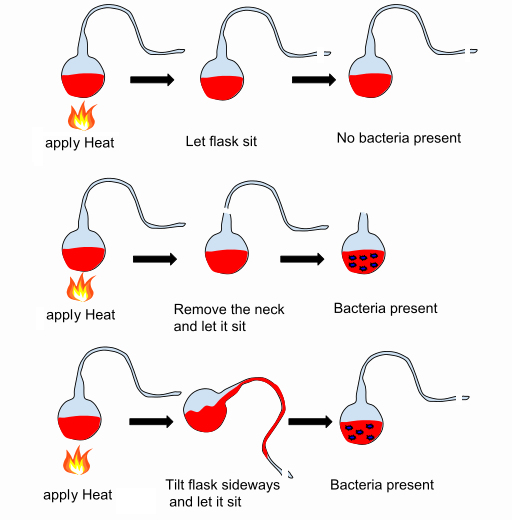
Pasteur Swan-Neck flask experiment (1861):
Experimental disproof of Spontaneous Generation
Earlier experiments to disprove spontaneous generation
as the cause of putrefaction had heated biological infusions
in sealed glass containers. Such cultures did not putrefy,
which seemed to disprove spontaneous generation. The
counterargument was that the process of heating destroyed
some vital property of the culture and (or) air that was
essential to support generation. That the sealed container
when opened and exposed to fresh air rapidly putrefied
seemed a valid objection.
Louis Pasteur devised the experiment illustrated above. He heated an infusion sealed in a vessel with a S-shaped or "Swan neck", let it cool, and then broke of the tip of the vessel. This allowed fresh air to enter, but any particulate matter was trapped in the bend of the neck. The culture did not putrefy, even though it had access to air. To answer the objection that some vital principle in the culture itself had been destroyed, Pasteur again heated the sealed flask, but this time broke the neck above the bend so that air could enter directly. The culture putrefied.
To answer the objection that the fresh air simply "re-activated" some vital principle in the culture, Pasteur repeated the first experiment, but this time tipped the culture so as to allow the infusion to contact the bend of the neck that was in contact with the outside. The culture putrefied, which showed that the source of putrefaction was outside the culture and not spontaneously generated within the culture.
Louis Pasteur devised the experiment illustrated above. He heated an infusion sealed in a vessel with a S-shaped or "Swan neck", let it cool, and then broke of the tip of the vessel. This allowed fresh air to enter, but any particulate matter was trapped in the bend of the neck. The culture did not putrefy, even though it had access to air. To answer the objection that some vital principle in the culture itself had been destroyed, Pasteur again heated the sealed flask, but this time broke the neck above the bend so that air could enter directly. The culture putrefied.
To answer the objection that the fresh air simply "re-activated" some vital principle in the culture, Pasteur repeated the first experiment, but this time tipped the culture so as to allow the infusion to contact the bend of the neck that was in contact with the outside. The culture putrefied, which showed that the source of putrefaction was outside the culture and not spontaneously generated within the culture.
Text material ©2020 by Steven M. Carr